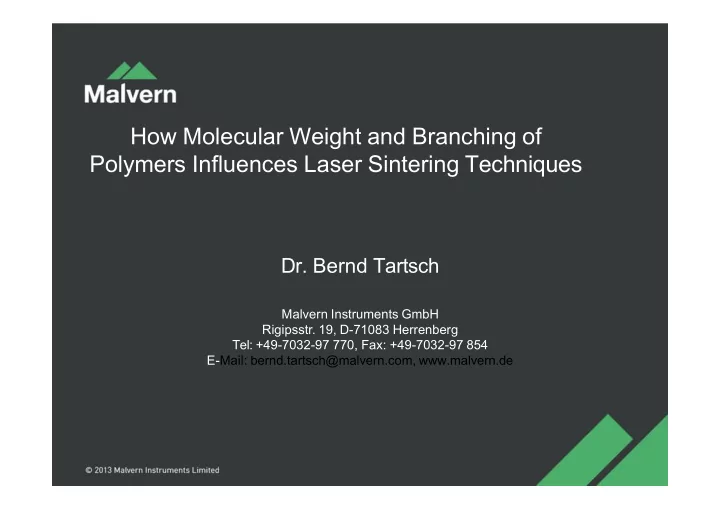

How Molecular Weight and Branching of Polymers Influences Laser Sintering Techniques Dr. Bernd Tartsch Malvern Instruments GmbH Rigipsstr. 19, D-71083 Herrenberg Tel: +49-7032-97 770, Fax: +49-7032-97 854 E-Mail: bernd.tartsch@malvern.com, www.malvern.de
Selective Laser sintering process Quelle: Wikipedia, Materialgeeza
Laser sintering applications › Prototyping › Functional tests/build in tests › Small serial production › Interpenetrating parts Quelle: NW Rapid Manufacturing Quelle: Ebyton Technology Quelle: Rapid Pro
Materials for laser sintering › Polyamide (modified) - high mechanical load capacity - temperature resistent (>150 °C) - resistent against bases, solvents, etc. › filled with glass beads or mineral fibers › Other thermoplastic elastomers › Ceramics › Metals
1. Challenge: Adding the next layer of material › Particle size determines smallest structure size (0,1 mm) › Particle size distribution and shape influences „flow“ of particles › Best properties: regular, equi-axed, non-porous particles Laser diffraction for particle Automated optical particle size characterization size and size distribution system adds shape information
2. Challenge: Recycling of unused material › Branching of polymer › Degradation of polymer What do we need as an analytical tool? Triple detection size exclusion chromatography
Why can‘t we use conventional GPC with RI? Potential branching 10,000 10,000 Log (Molekulargewicht) Log (Molekulargewicht) destroys the relation 100,000 100,000 between molecular weight and retention 400,000 400,000 volume (hydrodynamic radius). Mn, Mw, Mz Mn, Mw, Mz RI-Signalintensität RI-Signalintensität Mw/Mn Mw/Mn C i C i same Mw Elutionsvolumen (mL) Elutionsvolumen (mL) different radius
Absolute Molecular Weight by Rayleigh Light Scattering Scattered light at angle I Sample cell Laser I 0 Incident laser intensity Kc 1 2A c 2 R M P w θ θ Rayleigh ratio I /I 0 at angle R M w Weight average molecular weight 2 P Scattering function R /R 0 (0...1) 2 2 2 n dn c Concentration K 0 K Optical constant A 4 N dc A 2 2. Virial coefficient 0 n 0 Refractive index of solvent 0 Laser wavelength N A Avogadro number dn/dc Refractive index increment
Angular Dependence 90° 90° small molecules Laser Laser radius < 15 nm P θ = 1 for all θ large molecules Laser Laser 7° 7° radius > 15 nm P θ = 1 for θ = 0°
Molecular Weight Measurements Mw = 36.200 g/mol new PA 225 25 200 PDI = 1,23 175 20 Right Angle Light Scattering (mv) 150 Refractive Index (mv) 15 125 100 10 75 5 50 25 0 0 10 11 12 13 14 15 16 17 18 19 20 21 22 23 24 25 26 27 28 29 30 Retention Volume (mL) Mw = 88.300 g/mol 5 times used 225 50 200 PDI = 1,31 175 40 150 Right Angle Light Scattering (mv) Refractive Index (mv) 30 125 100 Chromatographic conditions: 20 75 50 Eluent: HFIP, 0.05 M K-acetate 10 25 Columns: 2x I-MBHMW 0 0 10 11 12 13 14 15 16 17 18 19 20 21 22 23 24 25 26 27 28 29 30 Retention Volume (mL) Flow rate: 0,5 ml/min Temperature: 45 °C
What do we need for branching? Zimm-Stockmayer-Theory Light Scattering Viscometer 1 / 2 (br) R (br) g g G (lin) 2 R (lin) M G M 3 [ ]M R h
Rg determination by Rayleigh Light Scattering Slope = R g 30 o Small molecules 45 o < 1/20 laser wavelength Intercept = Mw 60 o 90 o R θ /KC 120 o Slope ≈ 0 for Rg < 15 nm 135 o 150 o => No Rg Sin 2 ( /2)
R h or IV determination using the 4-Capillary Differential Viscometer IP + - Solvent - DP GPC IN OUT + Sample 4 DP Wheatstone bridge concept C IV sp Max Haney, 1983 IP 2 DP
Calculating the number of branches B. H. Zimm, W. H. Stockmayer,, 1. star branching J. Chem. Phys 17, 1301 (1949). 3 f 2 g 2 f f ... number of arms 2. trifunctional random – monodisperse in molecular weight 1 / 2 1 / 2 B 4 B g 1 n n 7 9 B n ... number of branches 3. trifunctional random – polydisperse in molecular weight 1 / 2 1 / 2 1 / 2 2 B 2 B B 6 1 g n ln n n 1 1 / 2 1 / 2 B 2 B 2 B B n n n n
Mark-Houwink-Plot or Branching View Linear species g Log IV branched species Log M Quelle: Wikipedia, Materialgeeza
Mark-Houiwnk-Plot of new and used PA new 1x used 2x used 5x used
Numeric Results Samples Mw PDI Branches new 36.200 1,23 Linear reference 1x used 52.400 1,28 1,18 2x used 65.700 1,27 1,43 5x used 88.300 1,31 1,89 Now the the data can be related with the behaviour in the laser sintering process and the amount of material that can be mixed with new material can be determined
Summary › GPC with triple detection provides a tool to determine the amount of material that can be recycled in a laser sintering process › Static Light Scattering is necessary in order to determine the absolute Mw of the branched polymers › Viscosity detection is necessary in order to measure branching of the polymers › In this case, the laser sintering process leads to a increase in molecular weight due to formation of branched structures.
Thank you for your attention
Recommend
More recommend